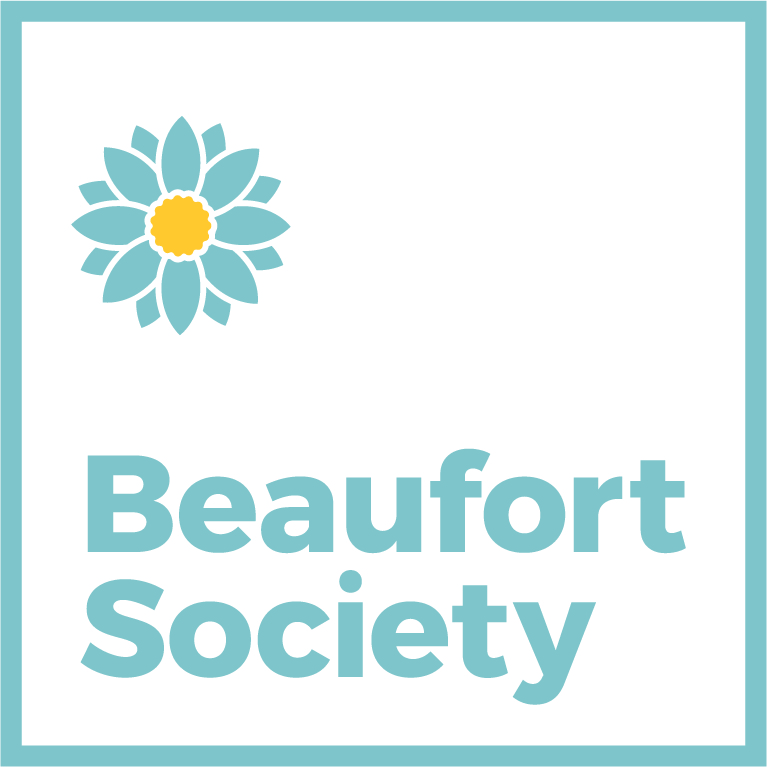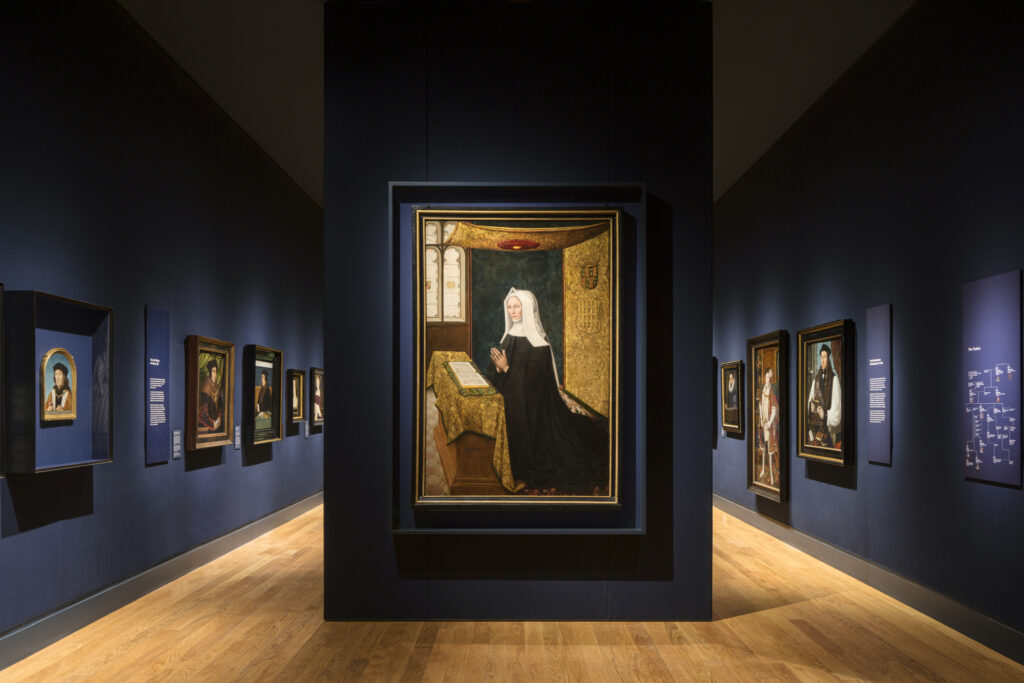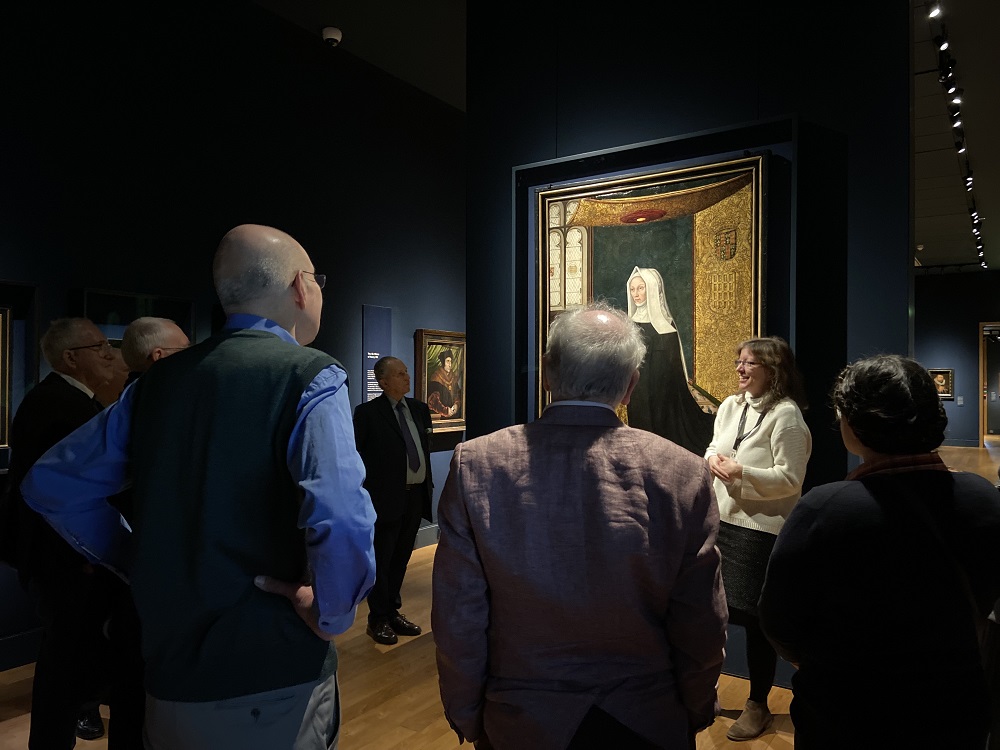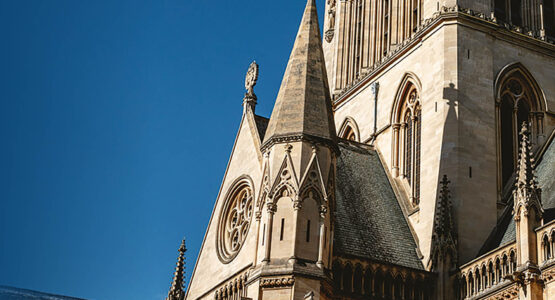
Following a period of conservation, Meynnart Wewyck’s portrait of Lady Margaret Beaufort has been loaned by St John’s College to hang as the centrepiece of the National Portrait Gallery’s Tudor exhibition. Members of the Beaufort Society went to see her in situ and learn more about the portrait’s historical and artistic significance.
A painting owned by the College of Lady Margaret Beaufort, Foundress of St John’s College and mother of King Henry VII, has been discovered to be one of the most important portraits of the early Tudor dynasty. It is now on display as the centrepiece of the new Tudor galleries at the National Portrait Gallery, London.

It has long been a focal point for conversation for visitors to the Master’s Lodge, and an extensive conservation project began in 2018 after Dr Andrew Chen, Art Historian and former Fellow of St John’s, and Dr Charlotte Bolland, Senior Curator for Research and 16th Century Collections at the National Portrait Gallery, discovered that the portrait had been painted by the sixteenth-century Netherlandish artist Meynnart Wewyck. Wewyck was one of the most significant painters in England at that time. He was an active member of King Henry VII’s court and became his preferred painter; however, his artworks have often eluded identification by art historians due to few surviving documents and the fact that artists rarely signed their works during this period.
In an article for the Burlington Magazine, Dr Chen and Dr Bolland presented new archival, scientific and stylistic evidence to re-date and re-attribute the portrait of Lady Margaret Beaufort. Their evidence established it as the earliest known full-length portrait of an English woman, dating from around the
time of the foundation of St John’s College in the early sixteenth century.
It is now understood to be the most important full-length English portrait before the arrival of the German artist Hans Holbein the Younger
The College’s Annual Fund financially supported the restoration of the portrait and its investigation by Christine Kimbriel and her expert colleagues at the Hamilton Kerr Institute, part of the Fitzwilliam Museum. One key revelation during the conservation process was that of Lady Margaret’s facial expression. The original depiction of her face had been painted over to appear more sombre and pious, and it has now been restored to the original visage.
It is now understood to be the most important full-length English portrait before the arrival of the German artist Hans Holbein the Younger and is remarkably still in its original Tudor frame. The frame provides key evidence to support the earlier dating of the work. The fact that the portrait still has its original engaged frame is unusual as they went out of fashion from the 1540s and few remain intact. Dendrochronological (tree ring dating) analysis of the panel revealed that it was constructed from four eastern Baltic oak boards from two trees that were felled in the late fifteenth century and were likely used in the early sixteenth century.
Although the conservation process became delayed due to the pandemic, the portrait now proudly hangs in the newly renovated National Portrait Gallery. It joined the Gallery at one of the most exciting times in its history after it reopened to the public following three years of closure and transformation.
We do miss Lady Margaret in College and are already looking forward to welcoming her home in a couple of years
Heather Hancock, Master
‘The National Portrait Gallery is incredibly grateful to St John’s College for the generous loan of the portrait of Lady Margaret Beaufort, which has had a transformative impact on the chronological presentation of the Collection. Displayed in Room 1 and celebrated as the earliest known full-length portrait of an Englishwoman, the portrait serves as a centrepiece for the discussion not only of Lady
Margaret’s significance, but also of the rise of the Tudor dynasty and the development of portraiture in England,’ said Dr Bolland.
Loaning the masterpiece to the collection at the National Portrait Gallery was a meaningful moment for St John’s, as it aligns with a number of the College’s core values. It not only enhances the reputation of St John’s as a steward of nationally significant historical artefacts, but also promotes scholarly research through the portrait’s exhibition. The College has a commitment to the responsible conservation of its historic environment by ensuring that objects are properly cared for and well researched. Such endeavours support the enrichment of the cultural life of our collegiate community and society at large. Supporting internationally significant research by our academics is central to the College’s mission, as
well as introducing the next generation to the excitement of original academic research.

On 7 March members of the Beaufort Society (named in honour of Lady Margaret) enjoyed an extra special spring meeting in London for an early morning viewing of the portrait in situ at the National Portrait Gallery. They gathered for a private tour with Charlotte Bolland and Catharine MacLeod, Senior
Curator of 17th Century Collections (and wife of St John’s Fellow Dr Frank Salmon). Split into two groups, members enjoyed learning from the expertise of both curators while the gallery was closed to the public. Following the tour a breakfast of tea, coffee and pastries was served in Larry’s, the Gallery’s café, where members met with the Master, Heather Hancock (1984).
The Master observed: ‘It is thrilling to see Lady Margaret in the National Portrait Gallery: she looks magnificent, quite rightly holding centre stage in the Tudor galleries in all her original glory. We were delighted to loan her restored portrait for the reopening of the Gallery, not only having discovered its importance in the development of portraiture, but to allow more people to encounter the remarkable story of this strong and courageous woman, to whom we owe the College’s existence. We do miss Lady
Margaret in College and are already looking forward to welcoming her home in a couple of years – although I have the feeling that she’ll be returning to a new place in the College, her splendour now deserving a more fitting location than next to the fireplace in the Master’s Lodge!’
The National Portrait Gallery is also borrowing the Great Bible from St John’s for the forthcoming
exhibition Six Lives: The Stories of Henry VIII’s Queens which opens on 20 June 2024.
If you are interested in more information about leaving a legacy to St John’s and joining the Beaufort
Society, please visit johnian.joh.cam.ac.uk/beaufortsociety, email Emma Talibudeen at beaufortsociety@joh.cam.ac.uk or ring her on 01223 338605.





